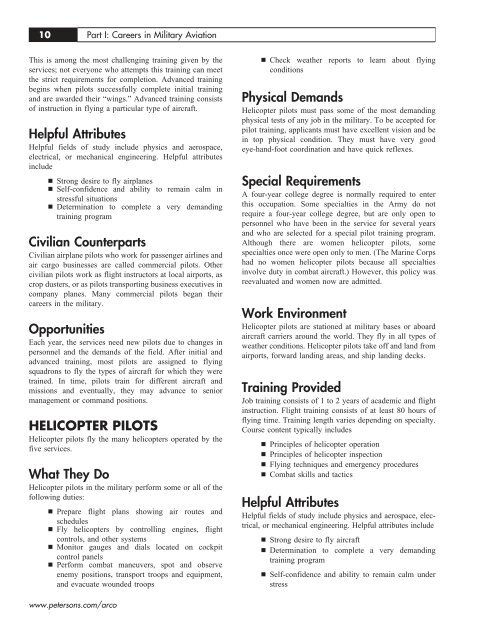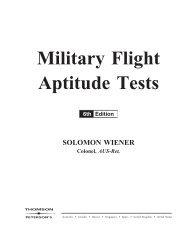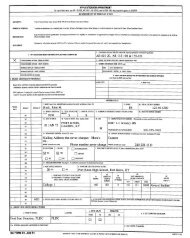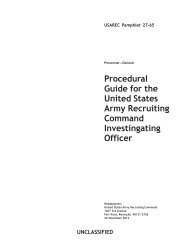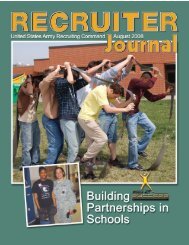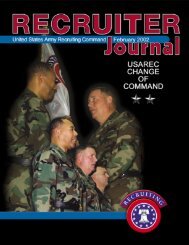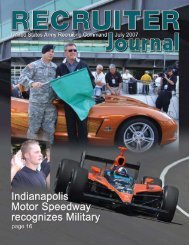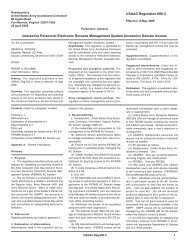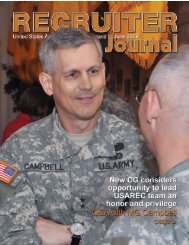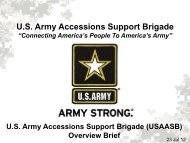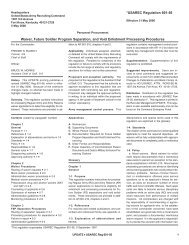Military Flight Aptitude Tests - USAREC - U.S. Army
Military Flight Aptitude Tests - USAREC - U.S. Army
Military Flight Aptitude Tests - USAREC - U.S. Army
You also want an ePaper? Increase the reach of your titles
YUMPU automatically turns print PDFs into web optimized ePapers that Google loves.
10 Part I: Careers in <strong>Military</strong> Aviation<br />
This is among the most challenging training given by the<br />
services; not everyone who attempts this training can meet<br />
the strict requirements for completion. Advanced training<br />
begins when pilots successfully complete initial training<br />
and are awarded their “wings.” Advanced training consists<br />
of instruction in flying a particular type of aircraft.<br />
Helpful Attributes<br />
Helpful fields of study include physics and aerospace,<br />
electrical, or mechanical engineering. Helpful attributes<br />
include<br />
n Strong desire to fly airplanes<br />
n Self-confidence and ability to remain calm in<br />
stressful situations<br />
n Determination to complete a very demanding<br />
training program<br />
Civilian Counterparts<br />
Civilian airplane pilots who work for passenger airlines and<br />
air cargo businesses are called commercial pilots. Other<br />
civilian pilots work as flight instructors at local airports, as<br />
crop dusters, or as pilots transporting business executives in<br />
company planes. Many commercial pilots began their<br />
careers in the military.<br />
Opportunities<br />
Each year, the services need new pilots due to changes in<br />
personnel and the demands of the field. After initial and<br />
advanced training, most pilots are assigned to flying<br />
squadrons to fly the types of aircraft for which they were<br />
trained. In time, pilots train for different aircraft and<br />
missions and eventually, they may advance to senior<br />
management or command positions.<br />
HELICOPTER PILOTS<br />
Helicopter pilots fly the many helicopters operated by the<br />
five services.<br />
What They Do<br />
Helicopter pilots in the military perform some or all of the<br />
following duties:<br />
n Prepare flight plans showing air routes and<br />
schedules<br />
n Fly helicopters by controlling engines, flight<br />
controls, and other systems<br />
n Monitor gauges and dials located on cockpit<br />
control panels<br />
n Perform combat maneuvers, spot and observe<br />
enemy positions, transport troops and equipment,<br />
and evacuate wounded troops<br />
www.petersons.com/arco<br />
n Check weather reports to learn about flying<br />
conditions<br />
Physical Demands<br />
Helicopter pilots must pass some of the most demanding<br />
physical tests of any job in the military. To be accepted for<br />
pilot training, applicants must have excellent vision and be<br />
in top physical condition. They must have very good<br />
eye-hand-foot coordination and have quick reflexes.<br />
Special Requirements<br />
A four-year college degree is normally required to enter<br />
this occupation. Some specialties in the <strong>Army</strong> do not<br />
require a four-year college degree, but are only open to<br />
personnel who have been in the service for several years<br />
and who are selected for a special pilot training program.<br />
Although there are women helicopter pilots, some<br />
specialties once were open only to men. (The Marine Corps<br />
had no women helicopter pilots because all specialties<br />
involve duty in combat aircraft.) However, this policy was<br />
reevaluated and women now are admitted.<br />
Work Environment<br />
Helicopter pilots are stationed at military bases or aboard<br />
aircraft carriers around the world. They fly in all types of<br />
weather conditions. Helicopter pilots take off and land from<br />
airports, forward landing areas, and ship landing decks.<br />
Training Provided<br />
Job training consists of 1 to 2 years of academic and flight<br />
instruction. <strong>Flight</strong> training consists of at least 80 hours of<br />
flying time. Training length varies depending on specialty.<br />
Course content typically includes<br />
n Principles of helicopter operation<br />
n Principles of helicopter inspection<br />
n Flying techniques and emergency procedures<br />
n Combat skills and tactics<br />
Helpful Attributes<br />
Helpful fields of study include physics and aerospace, electrical,<br />
or mechanical engineering. Helpful attributes include<br />
n Strong desire to fly aircraft<br />
n Determination to complete a very demanding<br />
training program<br />
n Self-confidence and ability to remain calm under<br />
stress


